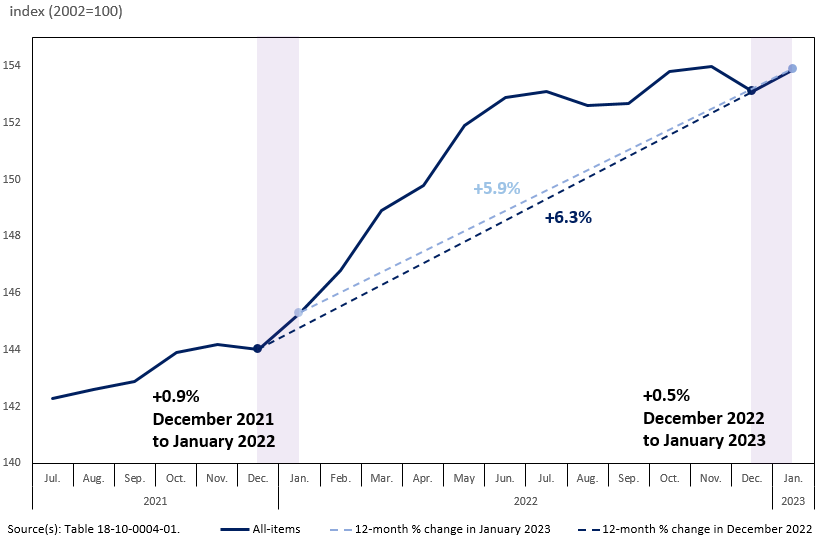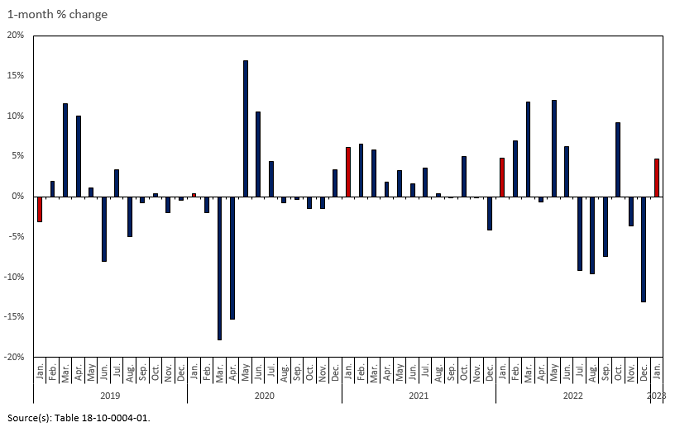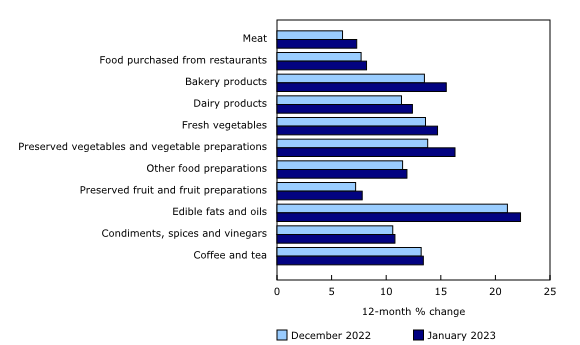Consumer Price Index, January 2023
Released: 2023-02-21
January 2023
5.9% 
(12-month change)
The Consumer Price Index (CPI) rose 5.9% year over year in January, following a 6.3% increase in December. Prices for cellular services and passenger vehicles contributed to the deceleration in the all-items CPI. However, mortgage interest cost and prices for food continue to rise.
In January, prices rose 4.9% on a year-over-year basis excluding food and energy and 5.4% excluding mortgage interest cost. In both cases, year-over-year price growth slowed compared with December.
The headline CPI grew at a slower pace year over year in January (+5.9%) compared with December (+6.3%) due to a base-year effect. This is because the monthly increase in January 2023 (+0.5%) was smaller than the monthly increase in January 2022 (+0.9%). In January 2022, mounting tensions amid the threat of a Russian invasion of Ukraine coupled with supply chain disruptions and higher prices for housing put upward pressure on prices.
On a monthly basis, the CPI rose 0.5% in January 2023 following a 0.6% decline in December. Higher gasoline prices contributed the most to the month-over-month increase, followed by a rise in mortgage interest cost and meat prices. On a seasonally adjusted monthly basis, the CPI rose 0.3%.
Base-year effects and the headline Consumer Price Index
The Consumer Price Index (CPI) is a standard measure of the price of a representative basket of goods and services. The headline consumer inflation is measured as the percentage change between the CPI in the current month (January 2023) and the CPI in a base month or the same calendar month of the previous year (January 2022).
A base-year effect refers to the impact that price movements from 12 months earlier have on the current month's headline consumer inflation. When a large 1-month upward price change in the base month stops influencing or falls out of the 12-month price movement, this has a downward effect on headline CPI in the current month. Conversely, a large 1-month downward price change in the base month creates upward pressure on the current month's 12-month figure.
In the first half of 2022, the global economy was significantly affected by the Russian invasion of Ukraine, and Canadian consumers experienced a significant increase in prices from January to June 2022. Headline consumer inflation increased from 5.1% in January to 8.1% in June 2022. The broad increase in prices in the early months of 2022, led by energy products, had a downward impact on the year-over-year rate of consumer inflation in January 2023, because higher prices from January 2022 were used as the basis for year-over-year comparison.
Price increases observed in the first half of 2022 will continue to fall out of the 12-month price movement. While inflation has slowed in recent months, prices remain elevated. Users should consider the impact of base-year effects when interpreting the 12-month price movement.
Consumers pay more at the pump in January compared with December
Gasoline prices contributed the most to the month-over-month increase in the all-items CPI, rising 4.7% in January. The price increase was related to refinery closures in the southwestern United States following winter storm Elliot.
On a year-over-year basis, prices for gasoline rose 2.9% in January, decelerating slightly from a 3.0% increase in December.
Consumers pay less for cellular services
Cellular service prices fell 7.9% on a year-over-year basis in January, following a 2.5% increase in December. Some Boxing Day sales remained available into January, leading to a decline when compared with the same month a year earlier.
Year-over-year passenger vehicle prices increase at a slower rate
Year over year, consumers paid 6.2% more for passenger vehicles in January following a 7.2% increase in December. This slowdown in price growth is partly attributable to a base-year effect, caused by a 0.9% month-over-month increase in January 2022, when prices were impacted by ongoing supply chain constraints. In comparison, vehicle prices declined 0.1% month over month in January 2023. Lower availability of new model-year vehicles in January 2023 compared with January 2022 may also be contributing to the year-over-year deceleration.
Shelter prices decelerate despite continued upward pressure from mortgage interest cost
On a year-over-year basis, shelter prices increased at a slower rate, rising 6.6% in January after a 7.0% increase in December. Growth in other owned accommodation expenses (+1.1%) and homeowners' replacement cost (+4.3%) continued to decelerate amid the ongoing cooling of the housing market.
At the same time, the mortgage interest cost index continued to rise at a faster year-over-year pace amid the higher interest rate environment, rising 21.2% in January, the largest increase since September 1982, following an 18.0% increase in December.
Food prices rise at a faster pace year over year
Food prices, which include both groceries and food from restaurants, rose at a slightly faster pace year over year in January (+10.4%) than in December (+10.1%).
Grocery price acceleration in January was driven in part by year-over-year growth in meat prices (+7.3%), resulting from the largest month-over-month increase since June 2004. Fresh or frozen chicken prices were a notable contributor to the gain, rising 9.0% in January compared with December, the largest monthly increase since September 1986. Among other factors, chicken prices rose amid stronger seasonal demand as well as ongoing supply constraints, elevated input costs and issues related to avian influenza. Additional acceleration was seen in year-over-year price increases for bakery products (+15.5%), dairy products (+12.4%) and fresh vegetables (+14.7%).
Food purchased from restaurants also rose at a faster pace, rising 8.2% in January following a 7.7% increase in December. The gain was the result of higher prices for fast food and takeout.
Regional highlights
Year over year, prices rose at a slower pace in January compared with December in nine provinces. Price growth slowed the most in Manitoba, the province with the largest deceleration in gasoline prices. At the same time, New Brunswick was the only province where prices rose at a faster pace in January, as price growth for gasoline accelerated the most compared with the rest of the country.
Lower energy prices in Alberta
Electricity prices in Alberta fell 45.6% in January compared with December, the largest monthly decline on record. The decline follows a provincial initiative to reduce electricity rates and increase the provincial electricity rebate.
Alberta was the only province with a year-over-year decline in gasoline prices (-6 .4%). This reflects the complete suspension of the provincial gas tax starting January 1, following the previous partial suspension.
Related posts:
Save up to $50,000 with the new GST rebate for first-time home buyers in Canada. Applies to new homes up to $1.5M. Learn how to qualify today.
Learn about home equity tax in Canada, its potential impact, and current developments as of 2024.








